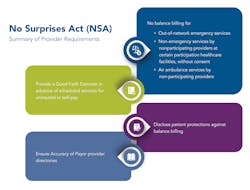Setting labs up for success amidst the No Surprises Act roll out
Price transparency has been a contentious issue for our country’s healthcare system for many years. The No Surprises Act (NSA)1 finally went into effect on January 1, 2022, after a multitude of delays. At its core, the Act established federal protections for patients against surprise medical bills and balance billing for services received from out-of-network providers — usually without their knowledge. While the legislation is new, the concept behind it is not.
As of January 1, 2022, consumers have billing protections when getting emergency care, non-emergency care, and air ambulance services from out-of-network providers. These new rules protect people by restricting excessive out-of-pocket costs and ensuring that these services continue to be covered without any prior authorization. Here’s what diagnostic laboratories need to know to make sure they are compliant.
What are surprise and balance billing?
Surprise billing is when patients unknowingly receive care from healthcare providers that worked with other providers that were outside their health plan’s network, resulting in high balance billing charges to the patient. This includes occasions when patients receive ancillary services, such as laboratory testing or diagnostic imaging, where they have little visibility into providers who are “behind the scenes.”
Balance billing occurs when an out-of-network provider bills the patient the difference between the provider’s charge amount and the payor’s allowed amount. This practice was often experienced when people received unplanned, or emergency care, which resulted in unexpected and (often) high medical bills. Over the years, this lack of information around charges for care have cost individual patients thousands of dollars in out-of-pocket expenses that they hadn’t planned for or anticipated.
It’s also important to remember that over the past few years, prior to the passing of the national legislation, more than 18 states2 had implemented legislation to address this issue and ban balance billing. In its current form, the NSA does not overrule existing legislation, but the Centers for Medicare & Medicaid Services (CMS) continues to monitor the prevalence of surprise billing for the possibility to expand the definition in future rulemaking.
The No Surprises Act and its requirements
NSA prohibits balance billing for emergency services, air ambulance services, and non-emergency services provided at participating healthcare facilities. It also provides protection for uninsured (or self-pay) individuals from unexpected “surprise” medical bills. A healthcare provider or facility must now provide a good faith estimate of the expected charges after an item or service is scheduled, or upon request.
This estimate includes expected charges for the service received, or for any other items that would reasonably be expected to be provided as part of the same scheduled service, which includes diagnostic and other ancillary services.
Ultimately, the act can be broken down into four requirements, which are outlined in the chart below.
Providers are also required to notify patients of protection under NSA by posting a notice at the provider’s physical location, posting a link on the searchable homepage of the provider’s website, and when requesting payment.
Six ways a billing vendor can help with compliance
Given these legislative changes, there are numerous reasons a healthcare provider may be out-of-network with a payor, and it’s more important than ever to leverage your billing system to help. In some cases, payors have closed networks and aren’t accepting new providers, or the provider and payor weren’t able to come to an agreement on rates for treatment. In addition, due to the numerous payors in the market, it’s often difficult to contract with every payor. As a result, most healthcare providers will not be in-network with all payors, and many will be impacted by the No Surprises Act.
Fortunately, revenue cycle management technology can help. In response to the evolving needs of patients, it’s crucial for labs to work with a trusted solution partner that can help guide the organization through this changing regulatory environment and maximize their RCM system and investment. The following are six ways providers can leverage their billing system to assist with compliance:
- Determine in-network rates — Identify any out-of-network payors and establish what their in-network rate is or work with the payor to outline a consistent approach, such as a percent of the fee schedule. This will allow providers to bill at an agreed-upon out-of-network rate from the start.
- Establish well-organized fee schedules — Within your billing system, categorize payors as contracted or non-contracted, and associate the specific fee schedule by payor. For out-of-network payors, your charge should equal the payor in-network allowable if it’s defined upfront.
- Contact patients sooner and proactively – When applicable, consider sending a letter to patients, informing them that their claim should be processed as in-network under the No Surprises Act. When utilized strategically, proactively educating patients can help alleviate patient confusion and patient phone calls.
- Educate representatives to better support patients – Educate patient service representatives on NSA so they’re prepared to handle incoming calls from patients. Additionally, look to implement a customer service workflow process to help ensure a consistent response to the incoming calls.
- Give patients greater cost visibility — Price estimation tools can improve the overall patient experience by helping them understand their out-of-pocket expenses. Leveraging an out-of-pocket estimation tool — which can be embedded into a patient portal and integrated with a lab’s RCM system — can proactively educate patients and help them understand any potential costs they are responsible for before a service is received, or a test is performed.
- Place holds on out-of-network payors — If your billing system doesn’t have the functionality to establish individual fee schedules by payor, consider placing out-of-network payors on hold for manual review to ensure the patient is billed the corresponding in-network rate.
By leveraging technology, a healthcare organization’s patients will experience greater price transparency and control over how and where they pay for services before tests are performed or services are received. With the right solution, labs can improve the process and management of their financial and communication strategies to be compliant right from the start. Working with a vendor that is steeped in knowledge and has a history of advocating for the lab industry will equip an organization with the tools and insights needed to navigate through this changing environment.
References:
- Centers for Medicare & Medicaid Services. Ending Surprise Medical Bills. https://www.cms.gov/nosurprises. Updated February 16, 2022. Accessed March 1, 2022.
- Kona M. State balance-billing protections. The Commonwealth Fund. https://www.commonwealthfund.org/publications/maps-and-interactives/2021/feb/state-balance-billing-protections. Updated February 5, 2021. Accessed March 1, 2022.
Kyle Fetter, MBA is Chief Operating Officer of XIFIN. He currently oversees sales, implementations, customer service and analytics for XIFIN in addition to the business process outsourcing divisions.
About the Author

Kyle Fetter, MBA
is Chief Operating Officer of XIFIN. He currently oversees sales, implementations, customer service and analytics for XIFIN in addition to the business process outsourcing divisions.

